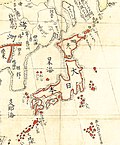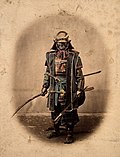The Azuchi–Momoyama period (安土桃山時代, Azuchi–Momoyama jidai) was the final phase of the Sengoku period (戦国時代, Sengoku jidai) in Japanese history from 1568...
29 KB (3,430 words) - 20:32, 4 October 2024
researchers agree that Azuchi Castle was the catalyst for the establishment of early modern castles in Japan from the Azuchi–Momoyama period onwards. Yamajiro...
17 KB (1,800 words) - 23:46, 18 November 2024
Fushimi Castle (redirect from Momoyama Castle)
replica constructed in 1964 near the original site in Fushimi. The Azuchi–Momoyama period of Japanese history partially takes its name from Fushimi Castle...
8 KB (710 words) - 10:26, 17 August 2024
History of Japan (redirect from Kamakura–Muromachi period)
Toyotomi Hideyoshi. The period takes its name from Nobunaga's headquarters, Azuchi Castle, and Hideyoshi's headquarters, Momoyama Castle. Nobunaga was the...
137 KB (16,278 words) - 12:17, 15 November 2024
Samurai (section Azuchi–Momoyama period)
bowmen, musketeers and horsemen were samurai". During the Azuchi–Momoyama period (late Sengoku period), "samurai" often referred to wakatō (若党), the lowest-ranking...
129 KB (15,702 words) - 00:49, 25 November 2024
cuff) than the body of the garment. During the Sengoku period (1467–1615)/Azuchi-Momoyama period (1568–1600), decoration of the kosode developed further...
67 KB (7,648 words) - 08:16, 17 November 2024
than the body of the garment. During the Sengoku period (1467–1615) and the Azuchi–Momoyama period (1568–1600), the decoration of the kosode developed...
129 KB (14,407 words) - 17:40, 24 October 2024
Oda Nobunaga enters Kyoto and ends the civil war, beginning the Azuchi–Momoyama period 1570: The Archbishopric of Edo is established and the first Japanese...
23 KB (2,921 words) - 10:49, 21 November 2024
Japanese architecture (section Azuchi-Momoyama period)
design as a counterpoint to the excesses of the aristocracy. In the Azuchi–Momoyama period (1568–1600), sukiya-zukuri style villas appeared under the influence...
91 KB (11,221 words) - 18:33, 14 October 2024
Oda Nobunaga (category People of Azuchi–Momoyama-period Japan)
Hideyoshi and Ieyasu. The period when Nobunaga and Hideyoshi were in power is called the Azuchi–Momoyama period. The name "Azuchi–Momoyama" comes from the fact...
172 KB (21,188 words) - 00:57, 9 November 2024
Wagashi (section Sengoku and Azuchi-Momoyama period)
with a zarame (ザラメ, coarse sugar) center. From the Sengoku period to the Azuchi-Momoyama period, wagashi developed along with the Japanese tea ceremony,...
31 KB (3,392 words) - 00:00, 19 November 2024
in the unification of Japan during the sixteenth century of the Azuchi–Momoyama period. The main keep of Osaka Castle is situated on a plot of land roughly...
21 KB (2,423 words) - 22:13, 24 October 2024
the now lost Azuchi Screens. The period in the history of Japan approximately between 1568 and 1603 is called Azuchi-Momoyama period. Azuchi Castle ruins...
2 KB (207 words) - 03:23, 17 April 2024
Shogun (section Azuchi–Momoyama period (1573–1603))
but eventually ran out of strength and was killed. The Azuchi-Momoyama period refers to the period when Oda Nobunaga and Toyotomi Hideyoshi were in power...
107 KB (10,995 words) - 09:45, 15 November 2024
During the Azuchi-Momoyama period (1573–1603), kilns throughout Japan produced ceramics with unconventional designs. In the early Edo period, the production...
52 KB (5,061 words) - 16:36, 29 October 2024
Japanese castle (section Azuchi–Momoyama period)
exception was Oda Nobunaga's Azuchi-Momoyama Castle, where he lived in the tenshu (main keep). Before the Sengoku period (roughly the 16th century), most...
63 KB (8,686 words) - 07:41, 28 October 2024
The following is a list of Japanese battles, organised by date. Jimmu's Eastern Expedition (c. 7th century BCE) Takehaniyasuhiko Rebellion (c. 1st century...
25 KB (2,728 words) - 15:28, 25 October 2024
– October 12, 1590) was a Japanese painter who lived during the Azuchi–Momoyama period of Japanese history and one of the most prominent patriarchs of...
7 KB (759 words) - 22:47, 19 April 2024
Japanese art (section Azuchi-Momoyama art)
the Edo period, it changed from practical accessories to art collections. The export of lacquerware continued following the Azuchi-Momoyama period. Marie...
108 KB (14,059 words) - 21:07, 22 November 2024
Kamakura period (1185-1333). During the Edo (Tokugawa)-period (1603–1868), Buddhism was controlled by the feudal Shogunate. The Meiji-period (1868–1912)...
99 KB (11,876 words) - 09:11, 20 November 2024
reproduced it in 2014. As the Sengoku period (period of warring states) ended and the Azuchi-Momoyama period to the Edo period started, katana-forging also developed...
68 KB (7,564 words) - 18:32, 20 November 2024
Motonobu (1476–1559) In sharp contrast to the previous Muromachi period, the Azuchi–Momoyama period was characterized by a grandiose polychrome style, with extensive...
40 KB (5,082 words) - 04:14, 12 February 2024
Japanese era name (section Azuchi–Momoyama period)
years for official papers. The five era names used since the end of the Edo period in 1868 can be abbreviated by taking the first letter of their romanized...
90 KB (4,193 words) - 02:32, 17 November 2024
Sengoku period, there are also various theories about the beginning and end dates of the following Azuchi-Momoyama period. The Azuchi-Momoyama period refers...
55 KB (5,641 words) - 16:05, 13 November 2024
Japanese sword (section Classification by period)
quality swords, but this technique was lost before the Azuchi–Momoyama period (Shintō period). The Sōshū school declined after the fall of the Kamakura...
134 KB (17,221 words) - 18:37, 20 November 2024
Kawachi Province (section Azuchi-Momoyama period)
around the Nanboku-chō period. Similarly, one for nuns was also near the same place, but it seems that it was in ruin by the Heian period. Hiraoka Shrine was...
25 KB (3,109 words) - 13:39, 26 September 2024
(cutting-edge down). In the Shintō period from around 1596 in the Azuchi–Momoyama period, the traditional techniques of the Kotō period were lost, and no smith was...
34 KB (3,585 words) - 16:48, 9 October 2024
Nōhime (category People of Sengoku-period Japan)
known as Kichō (帰蝶) was a Japanese woman from the Sengoku period to the Azuchi–Momoyama period. She was the daughter of Saitō Dōsan, a Sengoku Daimyō of...
24 KB (3,223 words) - 21:04, 14 October 2024
Shōgun (novel) (category Fiction set in 17th-century Sengoku period)
historical novel chronicling the end of Japan’s Azuchi-Momoyama period (1568-1600) and the dawn of the Edo period (1603-1868). Loosely based on actual events...
23 KB (2,627 words) - 14:17, 19 October 2024
List of time periods (redirect from Time period)
Muromachi period (1333–1573) Azuchi–Momoyama period (1573–1603) Modern Japan Edo period (1603–1868) Meiji period (1868–1912) Taishō period (1912–1926)...
29 KB (3,077 words) - 13:08, 24 November 2024

























